-
ADS788x 10-Bit, 8-Bit, 1.25-MSPS, Micro-Power, Miniature SAR Analog-to-Digital Converters
- 1 Features
- 2 Applications
- 3 Description
- 4 Revision History
- 5 Companion Products
- 6 Device Comparison
- 7 Pin Configuration and Functions
- 8 Specifications
- 9 Detailed Description
- 10Application and Implementation
- 11Power Supply Recommendations
- 12Layout
- 13Device and Documentation Support
- 14Mechanical, Packaging, and Orderable Information
- IMPORTANT NOTICE
Package Options
Mechanical Data (Package|Pins)
Thermal pad, mechanical data (Package|Pins)
Orderable Information
ADS788x 10-Bit, 8-Bit, 1.25-MSPS, Micro-Power, Miniature SAR Analog-to-Digital Converters
1 Features
- 1.25-MHz Sample Rate Serial Device
- 10-Bit Resolution (ADS7887)
- 8-Bit Resolution (ADS7888)
- Zero Latency
- 25-MHz Serial Interface
- Supply Range: 2.35 V to 5.25 V
- Typical Power Dissipation at 1.25 MSPS:
- 3.8 mW at 3-V VDD
- 8 mw at 5-V VDD
- ±0.35 LSB INL, DNL (ADS7887)
- ±0.15 LSB INL, ±0.1 LSB DNL (ADS7888)
- 61 dB SINAD, –84 dB THD (ADS7887)
- 49.5 dB SINAD, –67.5 dB THD (ADS7888)
- Unipolar Input Range: 0 V to VDD
- Power-Down Current: 1 µA
- Wide Input Bandwidth: 15 MHz at 3 dB
- 6-Pin SOT23 and SC70 Packages
2 Applications
- Base Band Converters in Radio Communication
- Motor Current and Bus Voltage Sensors in Digital Drives
- Optical Networking (DWDM, MEMS-Based Switching)
- Optical Sensors
- Battery-Powered Systems
- Medical Instrumentations
- High-Speed Data Acquisition Systems
- High-Speed Closed-Loop Systems
3 Description
The ADS7887 device is a 10-bit, 1.25-MSPS, analog-to-digital converter (ADC), and the ADS7888 device is a 8-bit, 1.25-MSPS ADC. These devices include a capacitor-based SAR A/D converter with inherent sample and hold. The serial interface in each device is controlled by the CS and SCLK signals for glueless connections with microprocessors and DSPs. The input signal is sampled with the falling edge of CS, and SCLK is used for conversion and serial data output.
The devices operate from a wide supply range from 2.35 V to 5.25 V. The low power consumption of the devices make them suitable for battery-powered applications. The devices also include a power-saving, power-down feature for when the devices are operated at lower conversion speeds.
The high level of the digital input to the device is not limited to device VDD. This means the digital input can go as high as 5.25 V when device supply is 2.35 V. This feature is useful when digital signals are coming from other circuit with different supply levels. Also this relaxes restriction on power-up sequencing.
The ADS7887 and ADS7888 are available in 6-pin SOT-23 and SC70 packages and are specified for operation from –40°C to 125°C.
Device Information(1)
| PART NUMBER | PACKAGE | BODY SIZE (NOM) |
|---|---|---|
| ADS7887 ADS7888 |
SOT-23 (6) | 2.90 mm × 1.60 mm |
| SC70 (6) | 2.00 mm × 1.25 mm |
- For all available packages, see the orderable addendum at the end of the data sheet.
Functional Block Diagram
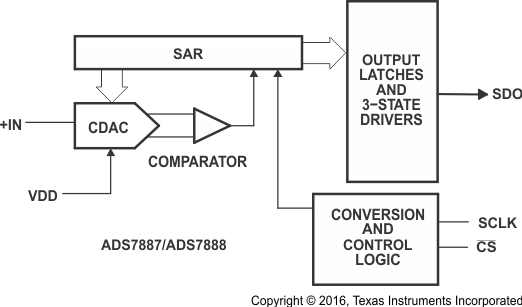
4 Revision History
Changes from * Revision (June 2005) to A Revision
- Added ESD Ratings table, Feature Description section, Device Functional Modes, Application and Implementation section, Power Supply Recommendations section, Layout section, Device and Documentation Support section, and Mechanical, Packaging, and Orderable Information sectionGo
- Changed Thermal Information tableGo
5 Companion Products
| PART NUMBER | NAME |
|---|---|
| SN74LVTH245A | 3.3-V ABT Octal Bus Transceivers With 3-State Outputs |
| LMV761 | Low Voltage, Precision Comparator with Push-Pull Output |
| TPS54418 | 2.95V to 6V Input, 4A Synchronous Step-Down SWIFT™ Converter |
| LMV339 | Quad General Purpose Low-Voltage Comparators |
| TPS730 | Low-Noise, High PSRR, RF 200-mA Low-Dropout Linear Regulators |
6 Device Comparison
| BIT | < 300 KSPS | 300 KSPS – 1.25 MSPS |
|---|---|---|
| 12-Bit | ADS7866 (1.2 VDD to 3.6 VDD) | ADS7886 (2.35 VDD to 5.25 VDD) |
| 10-Bit | ADS7867 (1.2 VDD to 3.6 VDD) | ADS7887 (2.35 VDD to 5.25 VDD) |
| 8-Bit | ADS7868 (1.2 VDD to 3.6 VDD) | ADS7888 (2.35 VDD to 5.25 VDD) |
7 Pin Configuration and Functions
Pin Functions
| PIN | I/O | DESCRIPTION | |
|---|---|---|---|
| NO. | NAME | ||
| 1 | VDD | — | Power supply input also acts like a reference voltage to ADC. |
| 2 | GND | — | Ground for power supply, all analog and digital signals are referred with respect to this pin. |
| 3 | VIN | I | Analog signal input |
| 4 | SCLK | I | Serial clock |
| 5 | SDO | O | Serial data out |
| 6 | CS | I | Chip select signal, active low |
8 Specifications
8.1 Absolute Maximum Ratings
over operating free-air temperature range (unless otherwise noted)(1)| MIN | MAX | UNIT | ||
|---|---|---|---|---|
| +IN to AGND | –0.3 | VDD + 0.3 | V | |
| +VDD to AGND | –0.3 | 7 | V | |
| Digital input voltage to GND | –0.3 | 7 | V | |
| Digital output to GND | –0.3 | VDD + 0.3 | V | |
| Power dissipation, both packages | (TJ(MAX) – TA) / RθJA | |||
| Lead temperature, soldering | Vapor phase (60 s) | 215 | °C | |
| Infrared (15 s) | 220 | |||
| Junction temperature, TJ(MAX) | 150 | °C | ||
| Storage temperature, Tstg | –65 | 150 | °C | |
8.2 ESD Ratings
| VALUE | UNIT | |||
|---|---|---|---|---|
| V(ESD) | Electrostatic discharge | Human-body model (HBM), per ANSI/ESDA/JEDEC JS-001(1) | ±2000 | V |
| Charged-device model (CDM), per JEDEC specification JESD22-C101(2) | ±500 | |||
8.3 Recommended Operating Conditions
over operating free-air temperature range (unless otherwise noted)| MIN | MAX | UNIT | ||
|---|---|---|---|---|
| TA | Operating temperature | –40 | 125 | °C |
8.4 Thermal Information
| THERMAL METRIC(1) | ADS7887, ADS7888 | UNIT | ||
|---|---|---|---|---|
| DBV (SOT-23) | DCK (SC70) | |||
| 6 PINS | 6 PINS | |||
| RθJA | Junction-to-ambient thermal resistance | 114.9 | 150.7 | °C/W |
| RθJC(top) | Junction-to-case (top) thermal resistance | 56.6 | 62.3 | °C/W |
| RθJB | Junction-to-board thermal resistance | 36.5 | 43 | °C/W |
| ψJT | Junction-to-top characterization parameter | 5.8 | 1.8 | °C/W |
| ψJB | Junction-to-board characterization parameter | 36.2 | 42.4 | °C/W |
| RθJC(bot) | Junction-to-case (bottom) thermal resistance | — | — | °C/W |
8.5 Electrical Characteristics – ADS7887
+VDD = 2.35 V to 5.25 V, TA = –40°C to 125°C, and fsample = 1.25 MHz (unless otherwise noted)| PARAMETER | TEST CONDITIONS | MIN | TYP | MAX | UNIT | |
|---|---|---|---|---|---|---|
| ANALOG INPUT | ||||||
| Full-scale input voltage span(1) | 0 | VDD | V | |||
| Absolute input voltage range | +IN | –0.2 | VDD + 0.2 | V | ||
| Ci | Input capacitance(2) | 21 | pF | |||
| IIlkg | Input leakage current | TA = 125°C | 40 | nA | ||
| SYSTEM PERFORMANCE | ||||||
| Resolution | 10 | Bits | ||||
| No missing codes | 10 | Bits | ||||
| INL | Integral nonlinearity | –0.75 | ±0.35 | 0.75 | LSB(3) | |
| DNL | Differential nonlinearity | –0.5 | ±0.35 | 0.5 | LSB | |
| EO | Offset error(4)(5)(6) | –1.5 | ±0.5 | 1.5 | LSB | |
| EG | Gain error(5) | –1 | ±0.5 | 1 | LSB | |
| SAMPLING DYNAMICS | ||||||
| Conversion time | 25-MHz SCLK | 530 | 560 | ns | ||
| Acquisition time | 260 | ns | ||||
| Maximum throughput rate | 25-MHz SCLK | 1.25 | MHz | |||
| Aperture delay | 5 | ns | ||||
| Step Response | 160 | ns | ||||
| Overvoltage recovery | 160 | ns | ||||
| DYNAMIC CHARACTERISTICS | ||||||
| THD | Total harmonic distortion(7) | 100 kHz | –84 | –72 | dB | |
| SINAD | Signal-to-noise and distortion | 100 kHz | 60.5 | 61 | dB | |
| SFDR | Spurious free dynamic range | 100 kHz | 73 | 81 | dB | |
| Full power bandwidth | At –3 dB | 15 | MHz | |||
| DIGITAL INPUT/OUTPUT | ||||||
| VIH | High-level input voltage | VDD = 2.35 V to 5.25 V | VDD – 0.4 | 5.25 | V | |
| VIL | Low-level input voltage | VDD = 5 V | 0.8 | V | ||
| VDD = 3 V | 0.4 | |||||
| VOH | High-level output voltage | At Isource = 200 µA | VDD – 0.2 | V | ||
| VOL | Low-level output voltage | At Isink = 200 µA | 0.4 | |||
| POWER SUPPLY REQUIREMENTS | ||||||
| +VDD | Supply voltage | 2.35 | 3.3 | 5.25 | V | |
| Supply current (normal mode) | At VDD = 2.35 V to 5.25 V, 1.25-MHz throughput |
2 | mA | |||
| At VDD = 2.35 V to 5.25 V, static state | 1.5 | |||||
| Power-down state supply current | SCLK off | 1 | µA | |||
| SCLK on (25 MHz) | 200 | |||||
| Power dissipation at 1.25-MHz throughput |
VDD = 5 V | 8 | 10 | mW | ||
| VDD = 3 V | 3.8 | 6 | ||||
| Power dissipation in static state | VDD = 5 V | 5.5 | 7.5 | mW | ||
| VDD = 3 V | 3 | 4.5 | ||||
| Power-down time | 0.1 | µs | ||||
| Power-up time | 0.8 | µs | ||||
| Invalid conversions after power up | 1 | |||||
8.6 Electrical Characteristics – ADS7888
+VDD = 2.35 V to 5.25 V, TA = –40°C to 125°C, and fsample = 1.25 MHz (unless otherwise noted)| PARAMETER | TEST CONDITIONS | MIN | TYP | MAX | UNIT | |
|---|---|---|---|---|---|---|
| ANALOG INPUT | ||||||
| Full-scale input voltage span(1) | 0 | VDD | V | |||
| Absolute input voltage range | +IN | –0.2 | VDD + 0.2 | V | ||
| Ci | Input capacitance(2) | 21 | pF | |||
| IIlkg | Input leakage current | TA = 125°C | 40 | nA | ||
| SYSTEM PERFORMANCE | ||||||
| Resolution | 8 | Bits | ||||
| No missing codes | 8 | Bits | ||||
| INL | Integral nonlinearity | –0.3 | ±0.15 | 0.3 | LSB(3) | |
| DNL | Differential nonlinearity | –0.3 | ±0.1 | 0.3 | LSB | |
| EO | Offset error(4) (5) (6) | –0.5 | ±0.15 | 0.5 | LSB | |
| EG | Gain error(5) | –0.5 | ±0.15 | 0.5 | LSB | |
| SAMPLING DYNAMICS | ||||||
| Conversion time | 25-MHz SCLK | 450 | 480 | ns | ||
| Acquisition time | 1.5 MSPS mode, see Figure 34 | 206 | ns | |||
| Maximum throughput rate | 25-MHz SCLK | 1.25 | MHz | |||
| Aperture delay | 5 | ns | ||||
| Step Response | 160 | ns | ||||
| Overvoltage recovery | 160 | ns | ||||
| DYNAMIC CHARACTERISTICS | ||||||
| THD | Total harmonic distortion(7) | 100 kHz | –67.5 | –65 | dB | |
| SINAD | Signal-to-noise and distortion | 100 kHz | 49 | 49.5 | dB | |
| SFDR | Spurious free dynamic range | 100 kHz | 65 | 77 | dB | |
| Full power bandwidth | At –3 dB | 15 | MHz | |||
| DIGITAL INPUT/OUTPUT | ||||||
| VIH | High-level input voltage | VDD = 2.35 V to 5.25 V | VDD – 0.4 | 5.25 | V | |
| VIL | Low-level input voltage | VDD = 5 V | 0.8 | V | ||
| VDD = 3 V | 0.4 | |||||
| VOH | High-level output voltage | At Isource = 200 µA | VDD – 0.2 | V | ||
| VOL | Low-level output voltage | At Isink = 200 µA | 0.4 | |||
| POWER SUPPLY REQUIREMENTS | ||||||
| +VDD | Supply voltage | 2.35 | 3.3 | 5.25 | V | |
| Supply current (normal mode) | At VDD = 2.35 V to 5.25 V, 1.25-MHz throughput | 2 | mA | |||
| At VDD = 2.35 V to 5.25 V, static state | 1.5 | |||||
| Power-down state supply current | SCLK off | 1 | µA | |||
| SCLK on (25 MHz) | 200 | |||||
| Power dissipation at 1.25 MHz throughput | VDD = 5 V | 8 | 10 | mW | ||
| VDD = 3 V | 3.8 | 6 | ||||
| Power dissipation in static state | VDD = 5 V | 5.5 | 7.5 | mW | ||
| VDD = 3 V | 3 | 4.5 | ||||
| Power-down time | 0.1 | µs | ||||
| Power-up time | 0.8 | µs | ||||
| Invalid conversions after power up | 1 | |||||
8.7 Timing Requirements
All specifications typical at TA = –40°C to 125°C and VDD = 2.35 V to 5.25 V (unless otherwise noted; see Figure 32)| PARAMETER | TEST CONDITIONS(1) | MIN | TYP | MAX | UNIT | ||
|---|---|---|---|---|---|---|---|
| tconv | Conversion time | ADS7887 | VDD = 3 V | 14 × tSCLK | ns | ||
| VDD = 5 V | 14 × tSCLK | ||||||
| ADS7888 | VDD = 3 V | 12 × tSCLK | |||||
| VDD = 5V | 12 × tSCLK | ||||||
| tq | Quiet time | Minimum time required from bus 3-state to start of next conversion | VDD = 3 V | 40 | ns | ||
| VDD = 5 V | 40 | ||||||
| td1 | Delay time | CS low to first data (0) out | VDD = 3 V | 15 | 25 | ns | |
| VDD = 5 V | 13 | 25 | |||||
| tsu1 | Setup time | CS low to SCLK low | VDD = 3 V | 10 | ns | ||
| VDD = 5 V | 10 | ||||||
| td2 | Delay time | SCLK falling to SDO | VDD = 3 V | 15 | 25 | ns | |
| VDD = 5 V | 13 | 25 | |||||
| th1 | Hold time | SCLK falling to data valid (with 50-pF load) | VDD < 3 V | 7 | ns | ||
| VDD > 5 V | 5.5 | ||||||
| td3 | Delay time | 16th SCLK falling edge to SDO 3-state | VDD = 3 V | 10 | 25 | ns | |
| VDD = 5 V | 8 | 20 | |||||
| tw1 | Pulse duration | CS | VDD = 3 V | 25 | 40 | ns | |
| VDD = 5 V | 25 | 40 | |||||
| td4 | Delay time | CS high to SDO 3-state, see Figure 34 | VDD = 3 V | 17 | 30 | ns | |
| VDD = 5 V | 15 | 25 | |||||
| twH | Pulse duration | SCLK high | VDD = 3 V | 0.4 × tSCLK | ns | ||
| VDD = 5 V | 0.4 × tSCLK | ||||||
| twL | Pulse duration | SCLK low | VDD = 3 V | 0.4 × tSCLK | ns | ||
| VDD = 5 V | 0.4 × tSCLK | ||||||
| Frequency | SCLK | VDD = 3 V | 25 | MHz | |||
| VDD = 5 V | 25 | ||||||
| td5 | Delay time | Second falling edge of clock and CS to enter in power down (use min spec not to accidently enter in power down, see Figure 35) | VDD = 3 V | –2 | 5 | ns | |
| VDD = 5 V | –2 | 5 | |||||
| td6 | Delay time | CS and 10th falling edge of clock to enter in power down (use max spec not to accidently enter in power down, see Figure 35) | VDD = 3 V | 2 | –5 | ns | |
| VDD = 5 V | 2 | –5 | |||||
8.8 Typical Characteristics
8.8.1 ADS7887 and ADS7888
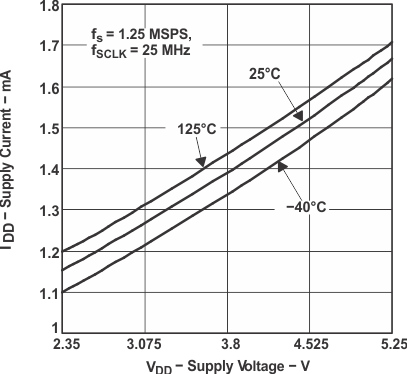 Figure 1. Supply Current vs Supply Voltage
Figure 1. Supply Current vs Supply Voltage
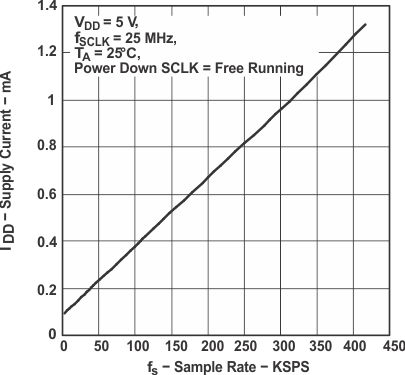 Figure 3. Supply Current vs Sample Rate
Figure 3. Supply Current vs Sample Rate
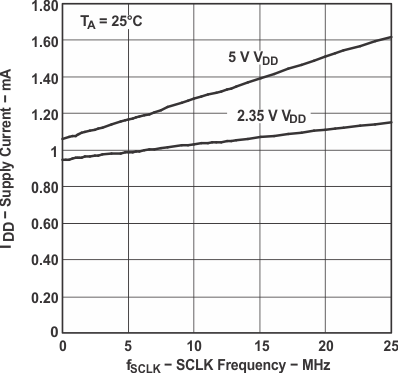 Figure 2. Supply Current vs SCLK Frequency
Figure 2. Supply Current vs SCLK Frequency
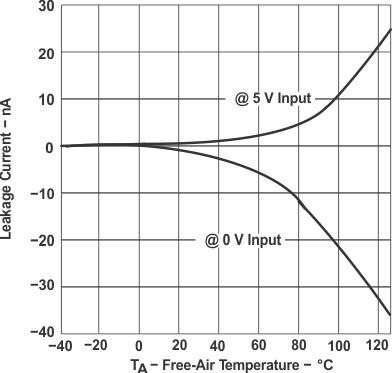 Figure 4. Analog Input Leakage Current
Figure 4. Analog Input Leakage Currentvs Free-Air Temperature
8.8.2 ADS7887 Only
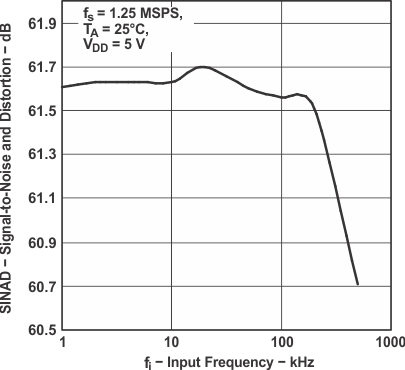 Figure 5. Signal-to-Noise and Distortion
Figure 5. Signal-to-Noise and Distortionvs Input Frequency
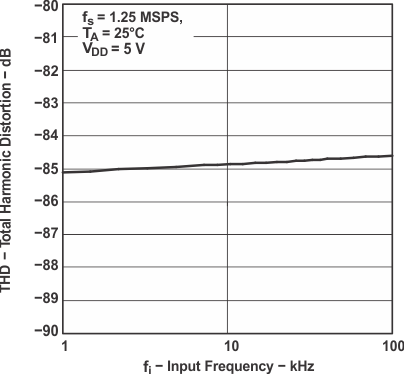 Figure 7. Total Harmonic Distortion
Figure 7. Total Harmonic Distortionvs Input Frequency
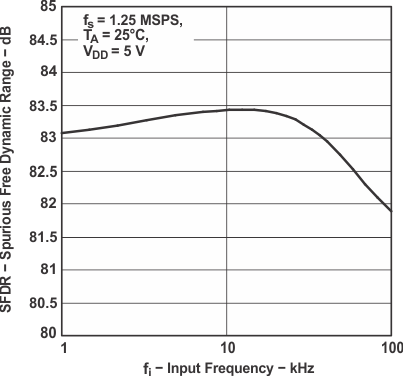 Figure 9. Spurious Free Dynamic Range
Figure 9. Spurious Free Dynamic Rangevs Input Frequency
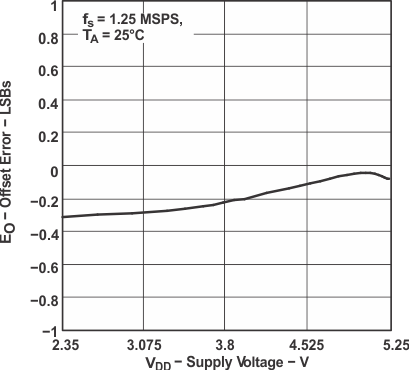 Figure 11. Offset Error vs Supply Voltage
Figure 11. Offset Error vs Supply Voltage
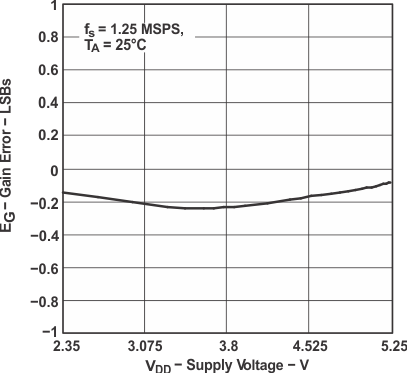 Figure 13. Gain Error vs Supply Voltage
Figure 13. Gain Error vs Supply Voltage
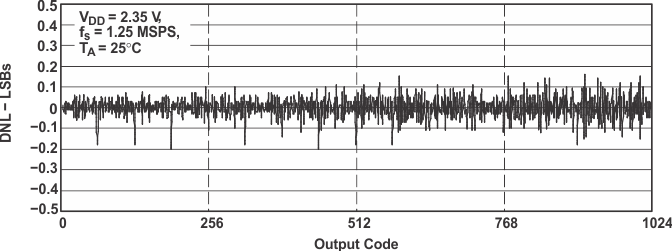 Figure 15. DNL
Figure 15. DNL
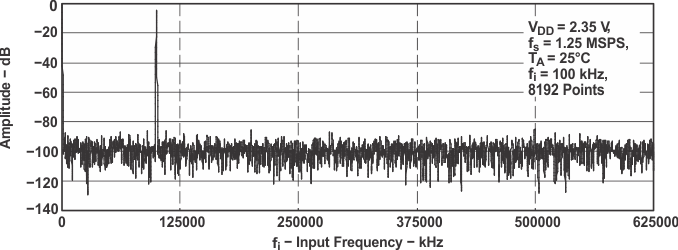 Figure 17. FFT
Figure 17. FFT
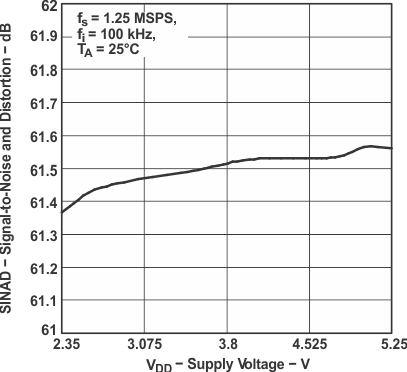 Figure 6. Signal-to-Noise and Distortion
Figure 6. Signal-to-Noise and Distortionvs Supply Voltage
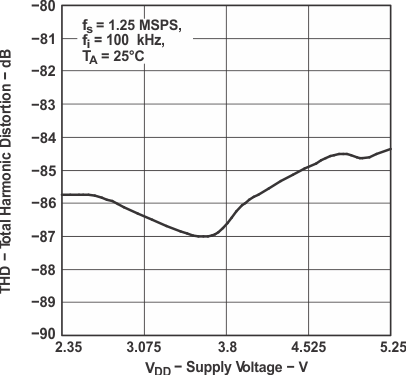 Figure 8. Total Harmonic Distortion
Figure 8. Total Harmonic Distortionvs Supply Voltage
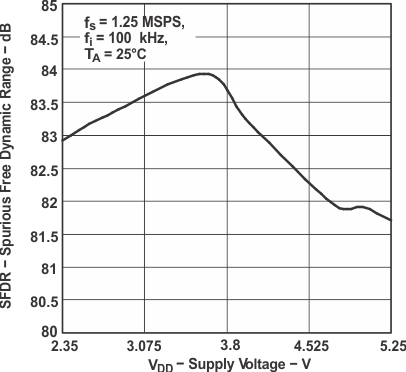 Figure 10. Spurious Free Dynamic Range
Figure 10. Spurious Free Dynamic Rangevs Supply Voltage
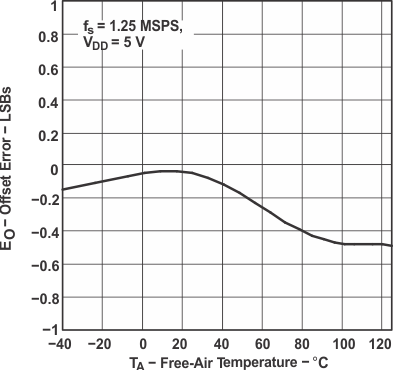 Figure 12. Offset Error vs Free-Air Temperature
Figure 12. Offset Error vs Free-Air Temperature
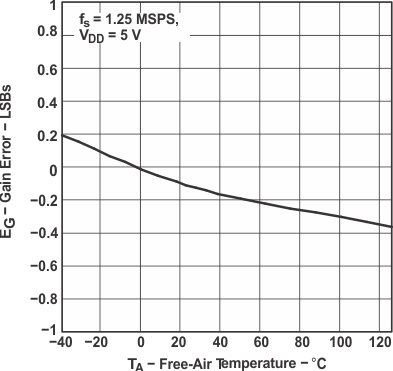 Figure 14. Gain Error vs Free-Air Temperature
Figure 14. Gain Error vs Free-Air Temperature
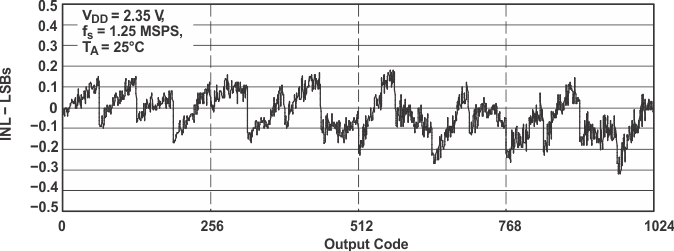 Figure 16. INL
Figure 16. INL
8.8.3 ADS7888 Only
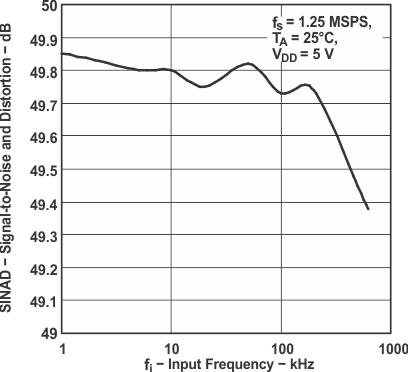 Figure 18. Signal-to-Noise and Distortion
Figure 18. Signal-to-Noise and Distortionvs Input Frequency
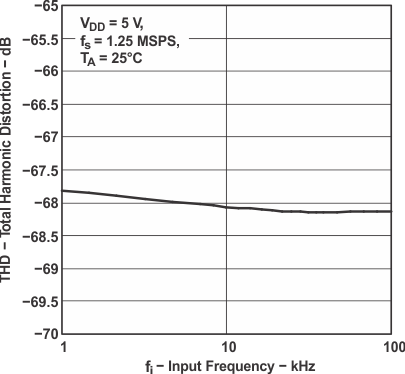 Figure 20. Total Harmonic Distortion
Figure 20. Total Harmonic Distortionvs Input Frequency
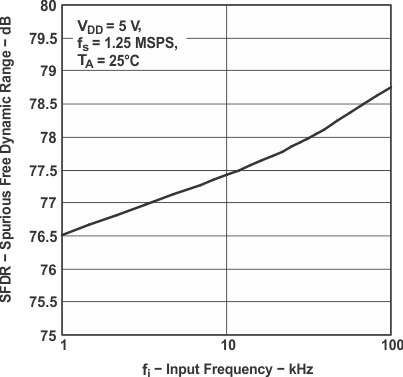 Figure 22. Spurious Free Dynamic Range
Figure 22. Spurious Free Dynamic Rangevs Input Frequency
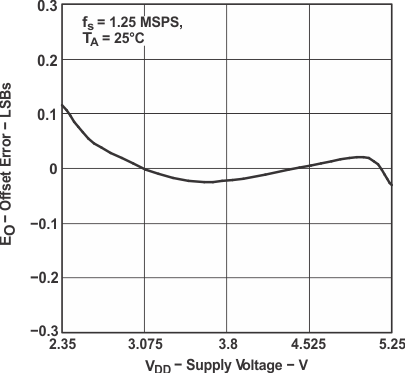 Figure 24. Offset Error vs Supply Voltage
Figure 24. Offset Error vs Supply Voltage
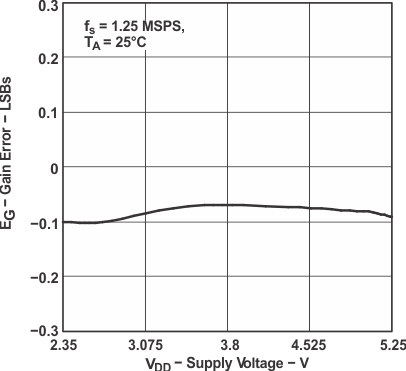 Figure 26. Gain Error vs Supply Voltage
Figure 26. Gain Error vs Supply Voltage
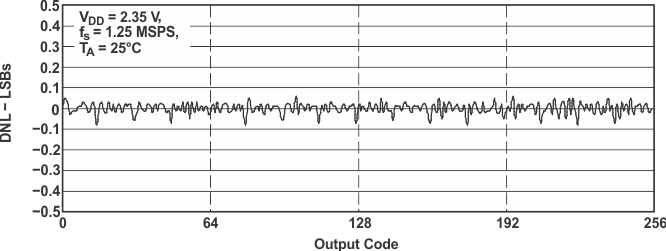 Figure 28. DNL
Figure 28. DNL
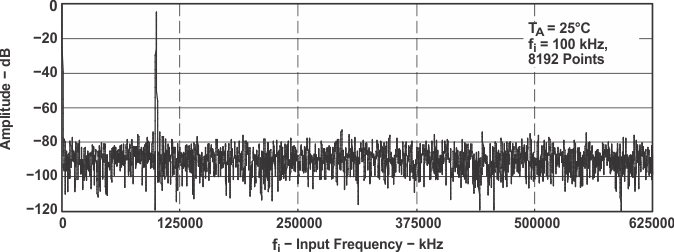 Figure 30. FFT
Figure 30. FFT
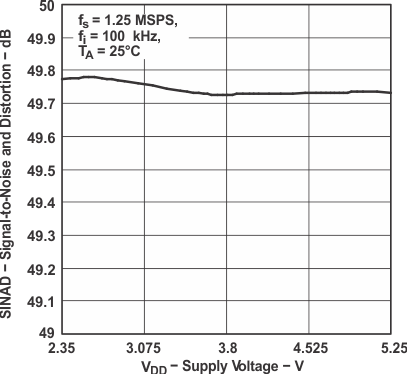 Figure 19. Signal-to-Noise and Distortion
Figure 19. Signal-to-Noise and Distortionvs Supply Voltage
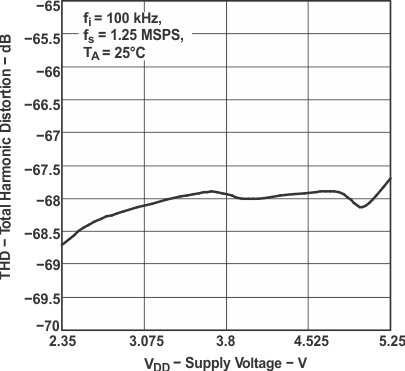 Figure 21. Total Harmonic Distortion
Figure 21. Total Harmonic Distortionvs Supply Voltage
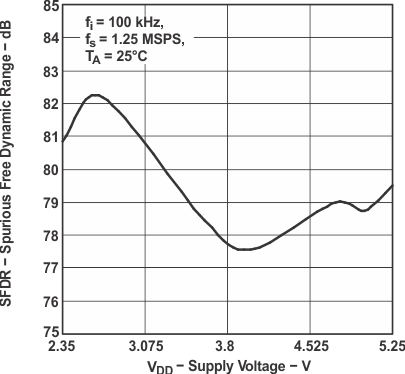 Figure 23. Spurious Free Dynamic Range
Figure 23. Spurious Free Dynamic Rangevs Supply Voltage
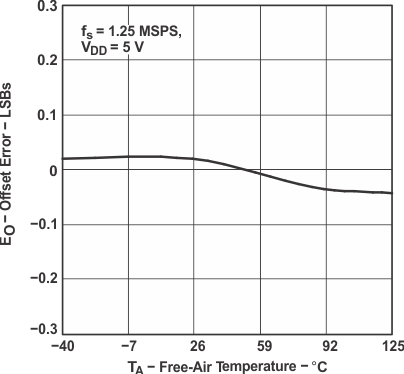 Figure 25. Offset Error vs Free-Air Temperature
Figure 25. Offset Error vs Free-Air Temperature
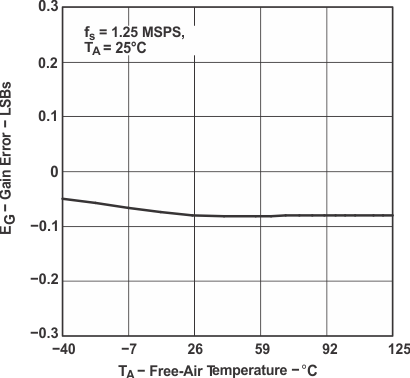 Figure 27. Gain Error vs Free-Air Temperature
Figure 27. Gain Error vs Free-Air Temperature
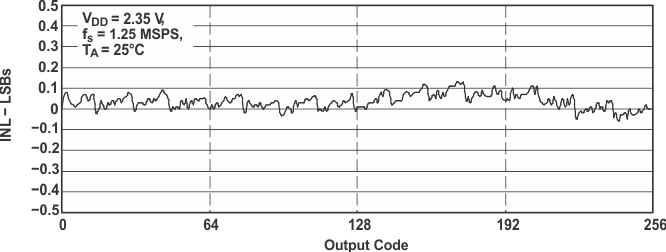 Figure 29. INL
Figure 29. INL
9 Detailed Description
9.1 Overview
The ADS788x devices are ADC converters. The serial interface in each device is controlled by the CS and SCLK signals for easy interface with microprocessors and DSPs. The input signal is sampled with the falling edge of CS, and SCLK is used for conversion and serial data output. They both operate in a wide supply range from 2.35 V to 5.25 V and low power consumption makes them suitable for battery-powered applications.
9.1.1 Driving the VIN and VDD Pins of the ADS7887 and ADS7888
The VIN input to the ADS7887 and ADS7888 must be driven with a low impedance source. In most cases additional buffers are not required. In cases where the source impedance exceeds 200 Ω, using a buffer would help achieve the rated performance of the converter. The THS4031 is a good choice for the driver amplifier buffer.
The reference voltage for the ADS7887 and ADS7888 A/D converters are derived from the supply voltage internally. The devices offer limited low-pass filtering functionality on-chip. The supply to these converters must be driven with a low impedance source and must be decoupled to the ground. A 1-µF storage capacitor and a 10-nF decoupling capacitor must be placed close to the device. Wide, low impedance traces must be used to connect the capacitor to the pins of the device. The ADS7887 and ADS7888 draw very little current from the supply lines. The supply line can be driven by either:
- Directly from the system supply.
- A reference output from a low drift and low dropout reference voltage generator like REF3030 or REF3130. The ADS7887 and ADS7888 can operate off a wide range of supply voltages. The actual choice of the reference voltage generator would depend upon the system. Figure 41 shows one possible application circuit.
- A low-pass filtered version of the system supply followed by a buffer like the zero-drift OPA735 can also be used in cases where the system power supply is noisy. Take care to ensure that the voltage at the VDD input does not exceed 7 V (especially during power up) to avoid damage to the converter. This can be done easily using single-supply CMOS amplifiers like the OPA735. Figure 42 shows one possible application circuit.
 Figure 31. Typical Equivalent Sampling Circuit
Figure 31. Typical Equivalent Sampling Circuit
9.2 Functional Block Diagram

9.3 Feature Description
9.3.1 ADS7887 Operation
The cycle begins with the falling edge of CS. This point is indicated as a in Figure 32. With the falling edge of CS, the input signal is sampled and the conversion process is initiated. The device outputs data while the conversion is in progress. The data word contains 4 leading zeros, followed by 10-bit data in MSB first format and padded by 2 lagging zeros.
The falling edge of CS clocks out the first zero, and a zero is clocked out on every falling edge of the clock until the third edge. Data is in MSB first format with the MSB being clocked out on the 4th falling edge. Data is padded with two lagging zeros as shown in Figure 32. On the 16th falling edge of SCLK, SDO goes to the 3-state condition. The conversion ends on the 14th falling edge of SCLK. The device enters the acquisition phase on the first rising edge of SCLK after the 13th falling edge. This point is indicated by b in Figure 32.
CS can be asserted (pulled high) after 16 clocks have elapsed. It is necessary not to start the next conversion by pulling CS low until the end of the quiet time (tq) after SDO goes to 3-state. To continue normal operation, it is necessary that CS is not pulled high until point b. Without this, the device does not enter the acquisition phase and no valid data is available in the next cycle (refer to Power-Down Mode for more details). CS going high any time after the conversion start aborts the ongoing conversion and SDO goes to 3-state.
The high level of the digital input to the device is not limited to device VDD. This means the digital input can go as high as 5.25 V when the device supply is 2.35 V. This feature is useful when digital signals are coming from another circuit with different supply levels. Also, this relaxes the restriction on power-up sequencing. However, the digital output levels (VOH and VOL) are governed by VDD as listed in Specifications.
 Figure 32. ADS7887 Interface Timing Diagram
Figure 32. ADS7887 Interface Timing Diagram
9.3.2 ADS7888 Operation
The cycle begins with the falling edge of CS . This point is indicated as a in Figure 33. With the falling edge of CS, the input signal is sampled and the conversion process is initiated. The device outputs data while the conversion is in progress. The data word contains 4 leading zeros, followed by 8-bit data in MSB first format and padded by 4 lagging zeros.
The falling edge of CS clocks out the first zero, and a zero is clocked out on every falling edge of the clock until the third edge. Data is in MSB first format with the MSB being clocked out on the 4th falling edge. Data is padded with four lagging zeros as shown in Figure 33. On the 16th falling edge of SCLK, SDO goes to the 3-state condition. The conversion ends on the 12th falling edge of SCLK. The device enters the acquisition phase on the first rising edge of SCLK after the 11th falling edge. This point is indicated by b in Figure 33.
CS can be asserted (pulled high) after 16 clocks have elapsed. It is necessary not to start the next conversion by pulling CS low until the end of the quiet time (tq) after SDO goes to 3-state. To continue normal operation, it is necessary that CS is not pulled high until point b. Without this, the device does not enter the acquisition phase and no valid data is available in the next cycle (refer to Power-Down Mode for more details). CS going high any time after the conversion start aborts the ongoing conversion and SDO goes to 3-state.
The high level of the digital input to the device is not limited to device VDD. This means the digital input can go as high as 5.25 V when the device supply is 2.35 V. This feature is useful when digital signals are coming from another circuit with different supply levels. Also, this relaxes the restriction on power-up sequencing. However, the digital output levels (VOH and VOL) are governed by VDD as listed in Specifications.
 Figure 33. ADS7888 Interface Timing Diagram
Figure 33. ADS7888 Interface Timing Diagram
As shown in Figure 34, the ADS7888 can achieve 1.5-MSPS throughput. CS can be pulled high after the 12th falling edge (with a 25-MHz SCLK). SDO goes to 3-state after the LSB (as CS is high). CS can be pulled low at the end of the quiet time (tq) after SDO goes to 3-state.
 Figure 34. ADS7888 Interface Timing Diagram, Data Transfer With 12-Clock Frame
Figure 34. ADS7888 Interface Timing Diagram, Data Transfer With 12-Clock Frame
9.4 Device Functional Modes
9.4.1 Power-Down Mode
The device enters power-down mode if CS goes high anytime after the 2nd SCLK falling edge to before the 10th SCLK falling edge. Ongoing conversion stops and SDO goes to 3-state under this power-down condition as shown in Figure 35.
 Figure 35. Entering Power-Down Mode
Figure 35. Entering Power-Down Mode
A dummy cycle with CS low for more than 10 SCLK falling edges brings the device out of power-down mode. For the device to come to the fully powered-up condition it takes 0.8 µs. CS can be pulled high any time after the 10th falling edge as shown in Figure 36. It is not necessary to continue until the 16th clock if the next conversion starts 0.8 µs after CS going low of the dummy cycle and the quiet time (tq) condition is met.
 Figure 36. Exiting Power-Down Mode
Figure 36. Exiting Power-Down Mode
10 Application and Implementation
NOTE
Information in the following applications sections is not part of the TI component specification, and TI does not warrant its accuracy or completeness. TI’s customers are responsible for determining suitability of components for their purposes. Customers should validate and test their design implementation to confirm system functionality.
10.1 Application Information
The primary circuits required to maximize the performance of a high-precision, the successive approximation register (SAR) and analog-to-digital converter (ADC), are the input driver and the reference driver circuits. This section details some general principles for designing the input driver circuit, references the driver circuit, and provides some application circuits designed for the ADS7887 and ADS7888.
10.2 Typical Application
 Figure 37. Typical Data Acquisition (DAQ) Circuit: Single-Supply DAQ
Figure 37. Typical Data Acquisition (DAQ) Circuit: Single-Supply DAQ
10.2.1 Design Requirements
The goal of this application is to design a single-supply digital acquisition (DAQ) circuit based on the ADS7887 with SNR greater than 61 dB and THD less than –84 dB for input frequencies of 2 kHz to 100 kHz at a throughput of 1.25 MSPS.
10.2.2 Detailed Design Procedure
To achieve a SINAD of 61 dB, the operational amplifier must have high bandwidth to settle the input signal within the acquisition time of the ADC. The operational amplifier must have low noise to keep the total system noise below 20% of the input-referred noise of the ADC. For the application circuit shown in Figure 37, OPA365 is selected for its high bandwidth (50 MHz) and low noise (4.5 nV√Hz).
The reference voltage for the ADS7887 and ADS7888 A/D converters are derived from the supply voltage internally. The supply to these converters must be driven with a low impedance source and must be decoupled to the ground. To drive supply pin of ADS7887 ultra low noise fast transient response low dropout voltage regulator TPS73201 is selected. Alternatively one can drive supply pin with low impedance voltage reference similar to REF3030.
For a step-by-step design procedure for low power, small form factor digital acquisition (DAQ) circuit based on similar SAR ADCs refer to TI Precision Design, Three 12-Bit Data Acquisition Reference Designs Optimized for Low Power and Ultra-Small Form Factor.
10.2.3 Application Curves

| SNR: 61.9 dB | THD: –86.8 dB | SINAD: 61.3 dB |

| SNR: 61.8 dB | THD: –85.1 dB | SINAD: 61.5 dB |
11 Power Supply Recommendations
The reference voltage for the ADS7887 and ADS7888 A/D converters are derived from the supply voltage internally. The supply to these converters must be driven with a low impedance source and must be decoupled to the ground Decouple the VDD with 1-µF ceramic decoupling capacitors, as shown in Figure 40. Always set the VDD supply to be greater than or equal to the maximum input signal to avoid saturation of codes.
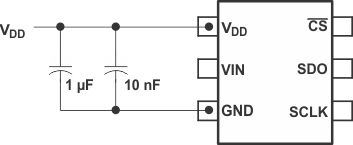 Figure 40. Supply and Reference Decoupling Capacitors
Figure 40. Supply and Reference Decoupling Capacitors
 Figure 41. Using the REF3030 Reference
Figure 41. Using the REF3030 Reference
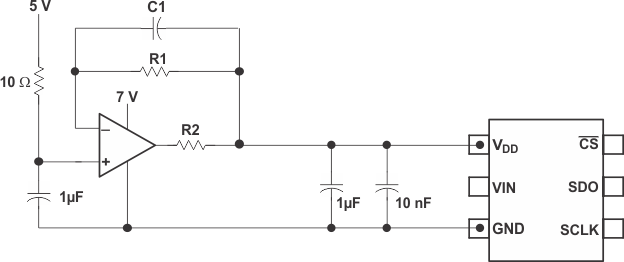 Figure 42. Buffering With the OPA735
Figure 42. Buffering With the OPA735
12 Layout
12.1 Layout Guidelines
Figure 43 shows a board layout example for the ADS7887 and ADS7888. Some of the key considerations are:
- Use a ground plane underneath the device and partition the PCB into analog and digital sections.
- Avoid crossing digital lines with the analog signal path.
- The power sources to the device must be clean and well-bypassed. Use 1-µF ceramic bypass capacitors in close proximity to the supply pin (VDD).
- Avoid placing vias between the VDD and bypass capacitors.
- Connect ground pin to the ground plane using short, low-impedance path.
- The fly-wheel RC filters are placed close to the device.
Among ceramic surface-mount capacitors, COG (NPO) ceramic capacitors provide the best capacitance precision. The type of dielectric used in COG (NPO) ceramic capacitors provides the most stable electrical properties over voltage, frequency, and temperature changes.
12.2 Layout Example
 Figure 43. ADS7887 and ADS7888 Example Layout
Figure 43. ADS7887 and ADS7888 Example Layout
13 Device and Documentation Support
13.1 Documentation Support
13.1.1 Related Documentation
For related documentation see the following:
13.2 Related Links
The table below lists quick access links. Categories include technical documents, support and community resources, tools and software, and quick access to sample or buy.
Table 1. Related Links
| PARTS | PRODUCT FOLDER | SAMPLE & BUY | TECHNICAL DOCUMENTS | TOOLS & SOFTWARE | SUPPORT & COMMUNITY |
|---|---|---|---|---|---|
| ADS7887 | Click here | Click here | Click here | Click here | Click here |
| ADS7888 | Click here | Click here | Click here | Click here | Click here |
13.3 Receiving Notification of Documentation Updates
To receive notification of documentation updates, navigate to the device product folder on ti.com. In the upper right corner, click on Alert me to register and receive a weekly digest of any product information that has changed. For change details, review the revision history included in any revised document.
13.4 Community Resources
The following links connect to TI community resources. Linked contents are provided "AS IS" by the respective contributors. They do not constitute TI specifications and do not necessarily reflect TI's views; see TI's Terms of Use.
-
TI E2E™ Online Community TI's Engineer-to-Engineer (E2E) Community. Created to foster collaboration among engineers. At e2e.ti.com, you can ask questions, share knowledge, explore ideas and help solve problems with fellow engineers.
-
Design Support TI's Design Support Quickly find helpful E2E forums along with design support tools and contact information for technical support.
13.5 Trademarks
E2E is a trademark of Texas Instruments.
All other trademarks are the property of their respective owners.
13.6 Electrostatic Discharge Caution

These devices have limited built-in ESD protection. The leads should be shorted together or the device placed in conductive foam during storage or handling to prevent electrostatic damage to the MOS gates.
13.7 Glossary
SLYZ022 — TI Glossary.
This glossary lists and explains terms, acronyms, and definitions.
14 Mechanical, Packaging, and Orderable Information
The following pages include mechanical, packaging, and orderable information. This information is the most current data available for the designated devices. This data is subject to change without notice and revision of this document. For browser-based versions of this data sheet, refer to the left-hand navigation.
IMPORTANT NOTICE
Texas Instruments Incorporated and its subsidiaries (TI) reserve the right to make corrections, enhancements, improvements and other changes to its semiconductor products and services per JESD46, latest issue, and to discontinue any product or service per JESD48, latest issue. Buyers should obtain the latest relevant information before placing orders and should verify that such information is current and complete. All semiconductor products (also referred to herein as "components") are sold subject to TI's terms and conditions of sale supplied at the time of order acknowledgment.
TI warrants performance of its components to the specifications applicable at the time of sale, in accordance with the warranty in TI's terms and conditions of sale of semiconductor products. Testing and other quality control techniques are used to the extent TI deems necessary to support this warranty. Except where mandated by applicable law, testing of all parameters of each component is not necessarily performed.
TI assumes no liability for applications assistance or the design of Buyers' products. Buyers are responsible for their products and applications using TI components. To minimize the risks associated with Buyers' products and applications, Buyers should provide adequate design and operating safeguards.
TI does not warrant or represent that any license, either express or implied, is granted under any patent right, copyright, mask work right, or other intellectual property right relating to any combination, machine, or process in which TI components or services are used. Information published by TI regarding third-party products or services does not constitute a license to use such products or services or a warranty or endorsement thereof. Use of such information may require a license from a third party under the patents or other intellectual property of the third party, or a license from TI under the patents or other intellectual property of TI.
Reproduction of significant portions of TI information in TI data books or data sheets is permissible only if reproduction is without alteration and is accompanied by all associated warranties, conditions, limitations, and notices. TI is not responsible or liable for such altered documentation. Information of third parties may be subject to additional restrictions.
Resale of TI components or services with statements different from or beyond the parameters stated by TI for that component or service voids all express and any implied warranties for the associated TI component or service and is an unfair and deceptive business practice. TI is not responsible or liable for any such statements.
Buyer acknowledges and agrees that it is solely responsible for compliance with all legal, regulatory and safety-related requirements concerning its products, and any use of TI components in its applications, notwithstanding any applications-related information or support that may be provided by TI. Buyer represents and agrees that it has all the necessary expertise to create and implement safeguards which anticipate dangerous consequences of failures, monitor failures and their consequences, lessen the likelihood of failures that might cause harm and take appropriate remedial actions. Buyer will fully indemnify TI and its representatives against any damages arising out of the use of any TI components in safety-critical applications.
In some cases, TI components may be promoted specifically to facilitate safety-related applications. With such components, TI's goal is to help enable customers to design and create their own end-product solutions that meet applicable functional safety standards and requirements. Nonetheless, such components are subject to these terms.
No TI components are authorized for use in FDA Class III (or similar life-critical medical equipment) unless authorized officers of the parties have executed a special agreement specifically governing such use.
Only those TI components which TI has specifically designated as military grade or "enhanced plastic" are designed and intended for use in military/aerospace applications or environments. Buyer acknowledges and agrees that any military or aerospace use of TI components which have not been so designated is solely at the Buyer's risk, and that Buyer is solely responsible for compliance with all legal and regulatory requirements in connection with such use.
TI has specifically designated certain components as meeting ISO/TS16949 requirements, mainly for automotive use. In any case of use of non-designated products, TI will not be responsible for any failure to meet ISO/TS16949.
Products
- Audio: www.ti.com/audio
- Amplifiers: amplifier.ti.com
- Data Converters: dataconverter.ti.com
- DLP® Products: www.dlp.com
- DSP: dsp.ti.com
- Clocks and Timers: www.ti.com/clocks
- Interface: interface.ti.com
- Logic: logic.ti.com
- Power Mgmt: power.ti.com
- Microcontrollers: microcontroller.ti.com
- RFID: www.ti.rfid.com
- OMAP Application Processors: www.ti.com/omap
- Wireless Connectivity: www.ti.com/wirelessconnectivity
Applications
- Automotive and Transportation: www.ti.com/automotive
- Communications and Telecom: www.ti.com/communications
- Computers and Peripherals: www.ti.com/computers
- Consumer Electronics: www.ti.com/consumer-apps
- Energy and Lighting: www.ti.com/energy
- Industrial: www.ti.com/industrial
- Medical: www.ti.com/medical
- Security: www.ti.com/security
- Space, Avionics and Defense: www.ti.com/space-avionics-defense
- Video & Imaging: www.ti.com/video
TI E2E Community : e2e.ti.com
Mailing Address: Texas Instruments, Post Office Box 655303, Dallas, Texas 75265
Copyright© 2016, Texas Instruments Incorporated